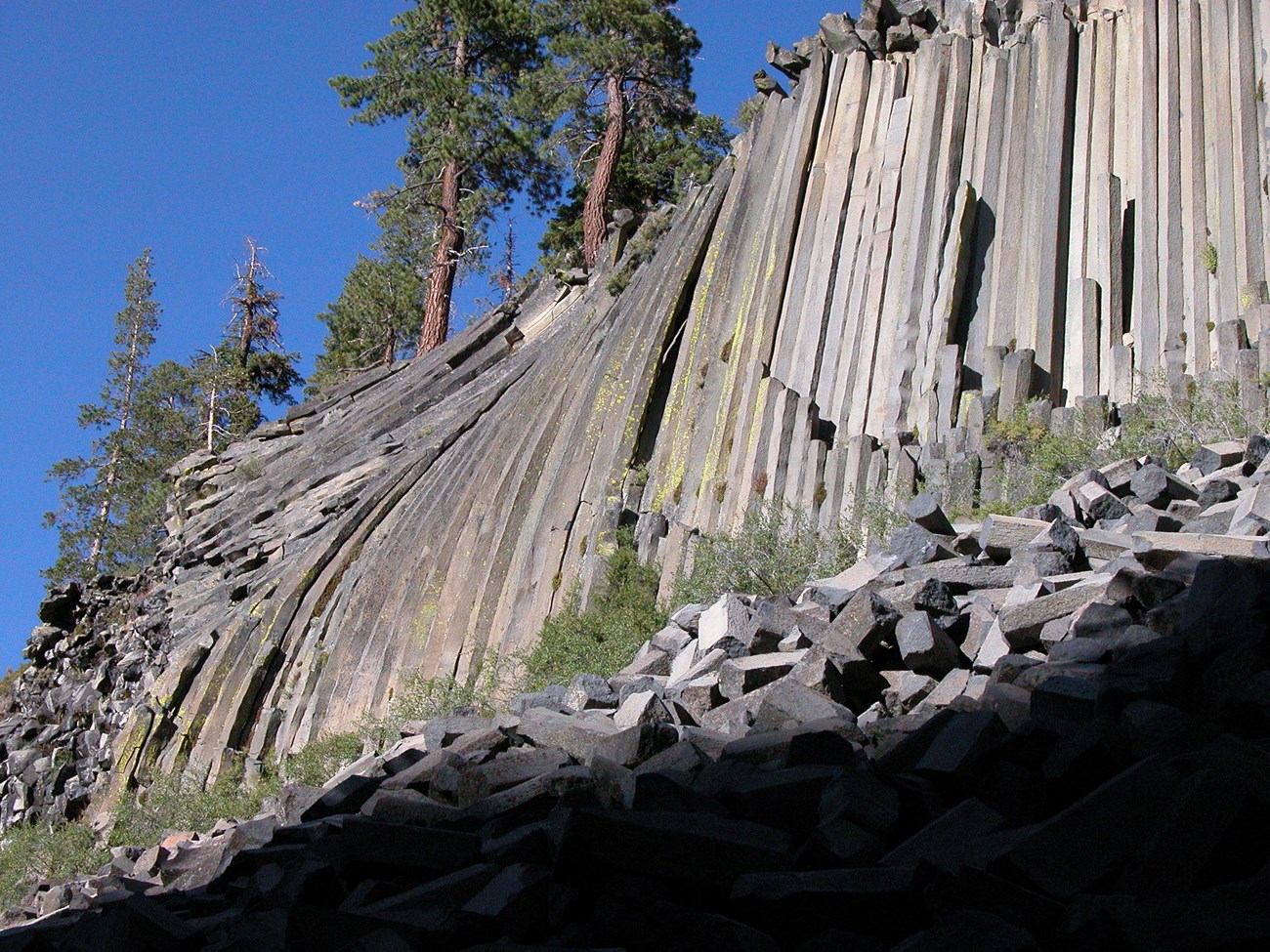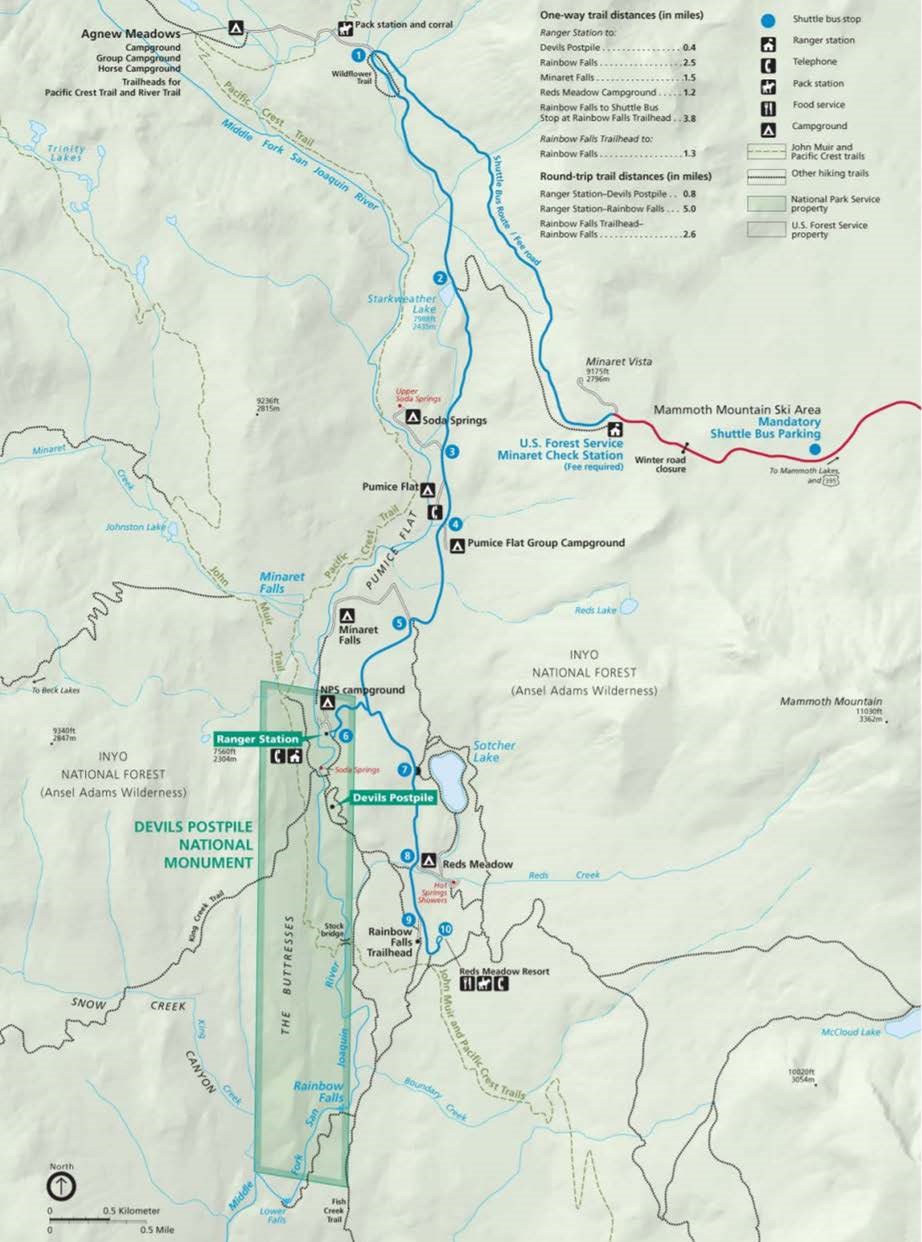Last updated: June 3, 2021
Article
Stratotype Inventory—Devils Postpile National Monument, California

NPS image.
Introduction
Devils Postpile National Monument (DEPO) was established on July 6, 1911 and is located 17 km (11 mi) southeast of YOSE in Madera County, California. The monument lies near the escarpment that defines the eastern edge of the Sierra Nevada fault block and encompasses approximately 324 hectares (800 acres; Figure 6). DEPO preserves and protects the glacially exposed columnar basalts of the Devils Postpile, the scenic Rainbow Falls, and the wilderness landscape of the upper Middle Fork San Joaquin River (Anderson 2017). The vertical columnar basalt at DEPO is world-renowned and a rare geological feature requiring homogeneous lava to solidify and crack under exceptionally uniform cooling conditions. These polygonal columns—the “posts” for which DEPO was named—stand 12 to 18 m (40 to 60 ft) high and are up to 1.1 m (3.5 ft) in diameter (Graham 2010). The columns are part of an informal geologic unit known as the Andesite of the Devils Postpile (Graham 2010). Traversing DEPO are both the John Muir Trail and Pacific Crest National Scenic Trail.

NPS image.
Significance and Geologic Resource Values
The geology of DEPO consists predominantly of Quaternary (2.6 million years ago to the present) extrusive volcanic rocks and Cretaceous (145 to 66 million years ago) intrusive igneous rocks. Rock units mapped in the vicinity of DEPO include Paleozoic- to Mesozoic-age metamorphosed sedimentary and volcanic rocks (Figure 7; Huber and Rinehart 1965). Approximately 82,000 years ago, a volcanic eruption filled the valley of the Middle Fork of the San Joaquin River with andesitic lava to a depth of 120 m (400 ft) (Hildreth et al. 2014). This remarkably deep lava flow would slowly cool to form the columnar features the monument takes its name after. After the lava solidified, Pleistocene glacial erosion removed approximately half of the flow, exposing the thick interior and sides of the columns (Graham 2010). Other volcanic features present in DEPO include the volcanic cliffs of The Buttresses and the 31 m (101 ft)-tall Rainbow Falls, both of which resulted from separate lava flows.

NPS image.
Stratotypes in Devils Postpile National Monument
As of the writing of this paper, there are no designated stratotypes identified within the boundaries of DEPO. In addition to the designated stratotypes located within DEPO boundaries, a list of stratotypes located within 48 km (30 mi) of park boundaries is included here for reference. These nearby stratotypes include:
- Triassic
- Scheelite Intrusive Suite (type area)
- Wheeler Crest Granodiorite (type locality)
- Cretaceous
- John Muir Intrusive Suite (type area)
- Lake Edison Granodiorite (type locality)
- Round Valley Peak Granodiorite (type locality)
- Mount Givens Granodiorite (reference locality)
- Pleistocene
- Bishop Tuff (type locality)
- Tenaya Till (type locality)
- Till of Sherwin Glaciation (type locality)
- Recess Peak Till (type locality)
Type Section Inventory Report—Sierra Nevada Inventory & Monitoring Network

The information on this page is excerpted from a report covering three parks within the Sierra Nevada Inventory and Monitoring Network (SIEN):
The full Network report is available in digital format from the Sierra Nevada Inventory and Monitoring Network and Natural Resource Publications Management websites. To receive this report in a format optimized for screen readers, please email irma@nps.gov.
Please cite this publication as:
- Henderson T, Santucci VL, Connors T, Tweet JS. 2021. National Park Service geologic type section inventory: Sierra Nevada Inventory & Monitoring Network. Natural Resource Report. NPS/SIEN/NRR—2021/2219. National Park Service. Fort Collins, Colorado. https://irma.nps.gov/DataStore/Reference/Profile/2284063
Leave No Trace—Protect Type Sections for Science

Many type sections and paleontological sites are vunerable to damage from careless visitation and over-use. Be sure to practice Leave No Trace princples whenever you are in the outdoors. Of particular importance at geoheritage sites is to:
-
Travel and camp on durable surfaces, and
-
Leave what you find.
If you see signs of vandalism or someone acting inappropriately during your visit to a park site, please contact a ranger at the park or make a report through NPS Investigative Services.
Related Links
- Devils Postpile National Monument, California—[Geodiversity Atlas] [Park Home] [NPSHistory.com]
- Geologic Time Scale
- America's Geoheritage
- NPS Paleontological Resource Inventory
- NPS Geologic Resources Inventory
- NPS Geodiversity Atlas
